In Lima’s poorest districts, bands of citizens have assembled through social media to fight crime, often employing brutal tactics. But are they any different than the gangsters they target?
On the morning of February 3, 2014, Marco Luigi Socola Farfán, a drug-addled gang member in his early 20s, was dropped off in El Cerro de San Cosme in La Victoria, a district in Lima. He wasn’t from the area, had never been there before, and didn’t plan on staying long
The barrio, a vast and ramshackle slum built on one of Lima’s many hills, loomed above him. Some of the neighborhood’s buildings had crumbled, like wet sugar-cubes, into fine rubble. As Farfán walked the narrow alleyways, he passed dilapidated homes with windows protected by thick metal bars and doors made of steel. Above him, residents streamed down the hill to the commercial morass of stalls and rundown shops that sat at its foot.
Farfán had been snorting methamphetamine all morning. He fumbled absentmindedly with the gun in his pocket and hooked the thumb of his other hand inside his bulletproof vest, picking at its stitching. He wanted the job to be over and done with. Farfán had been sent here for a specific, bloody task: To murder a man named Elmo Ramos Acosta.
That morning Acosta was nearby at the Estadio de San Cosme, a public park in the center of the neighborhood, conducting a meeting with members of a community organization called GREVA, an acronym for The Union of Resocialization for the District of Victoria. Acosta founded GREVA in 2007. The group was comprised of reformed ex-convicts, was organized largely through Facebook, and formed part of a grassroots movement to combat rising crime that had resulted from the country’s flourishing drug trade. Peru is the world’s second largest producer of cocaine, and suffers from some of the highest crime rates in South America. El Cerro de San Cosme is one of the worst affected areas.
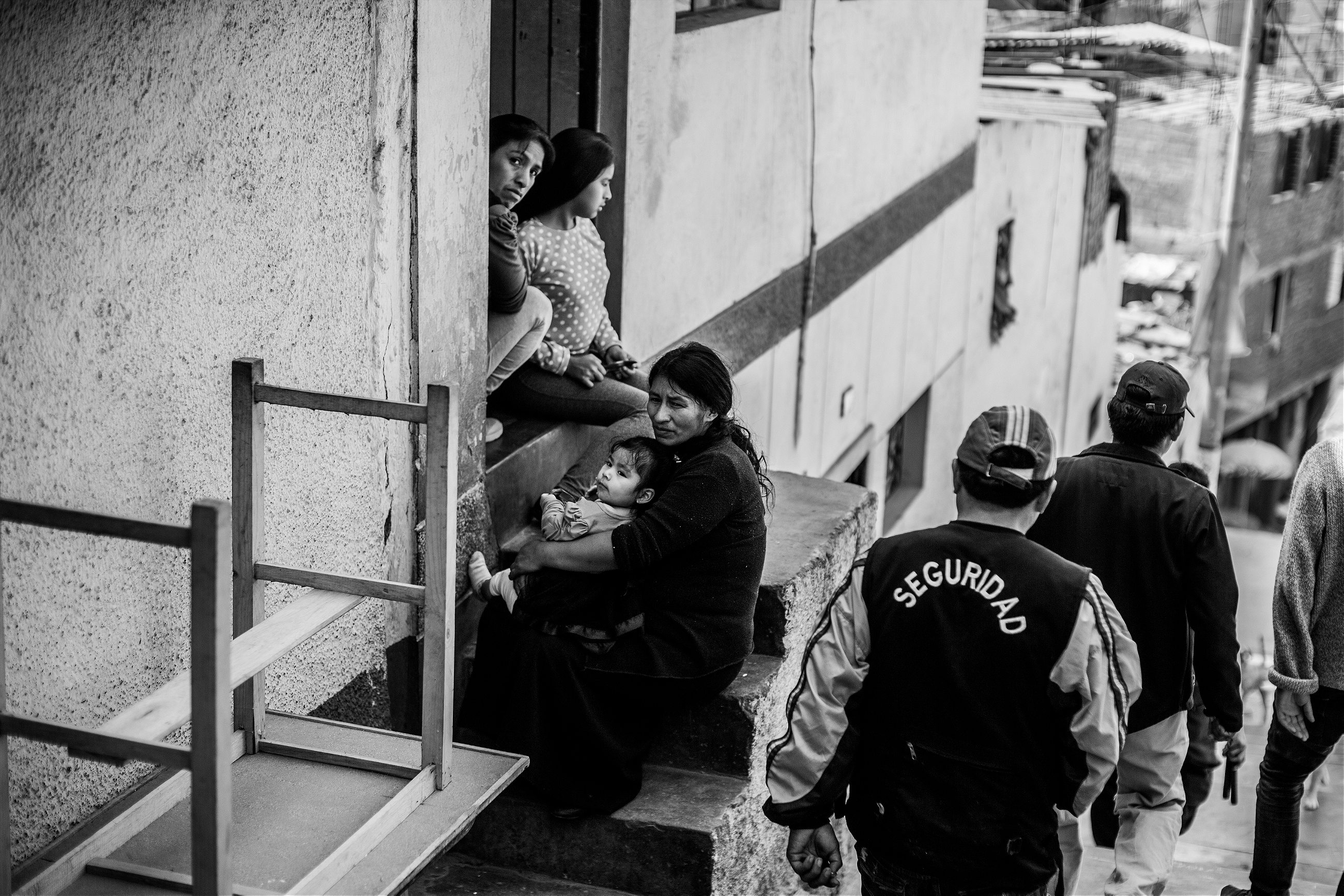
GREVA patrolled the slum, capturing criminals and drug-addicts and handing them over to the police. Because of these actions, Acosta was respected by many locals, and his men were famously loyal to him. He’d had problems with the authorities in the past, but as far as his supporters were concerned, he had no real enemies in San Cosme.
Farfán knew none of this; he had never met Acosta before—he’d never even he heard of him. Killing Acosta would be nothing more than another job, and all he had to work from was a photograph.
But that morning Farfán—a hitman from the Los Piuranos gang, with no previous convictions—was having trouble finding his victim. He searched the slum high and low but saw no sign of Acosta. The more time that passed, the more vulnerable he felt.
Around him, the traffic grumbled and hissed. Farfán snorted another line and peered out at the park through clouded, bloodshot eyes. He rummaged in his pocket for the gun, gripping it tightly, and muttering to himself.
GREVA members spotted Farfán pacing back and forth at the side of the road. He’d been there for a while, prowling, they said, like a caged tiger. One of the men shouted at him, asking him what he was doing in the neighborhood. Stirred from his drug-induced fog by the man’s aggressive tone, Farfán panicked. He ran, stumbling away from his interlocutor towards the steep streets of central San Cosme. The pistol he had been concealing in his pocket was now in his hand.
The would-be assassin didn’t get very far. Disorientated by the labyrinthine streets, Farfán was soon lost and surrounded by furious neighbors loyal to GREVA. The locals confiscated his pistol, tied him up, and began to beat him ceaselessly, filming the event on their smartphones.
The crowd around him grew and soon there were hundreds of people kicking and cursing. Before the police came to save his life, a battered and bruised Farfán confessed that a man he knew only as Quijandría had ordered him to kill Acosta in exchange for around $300.
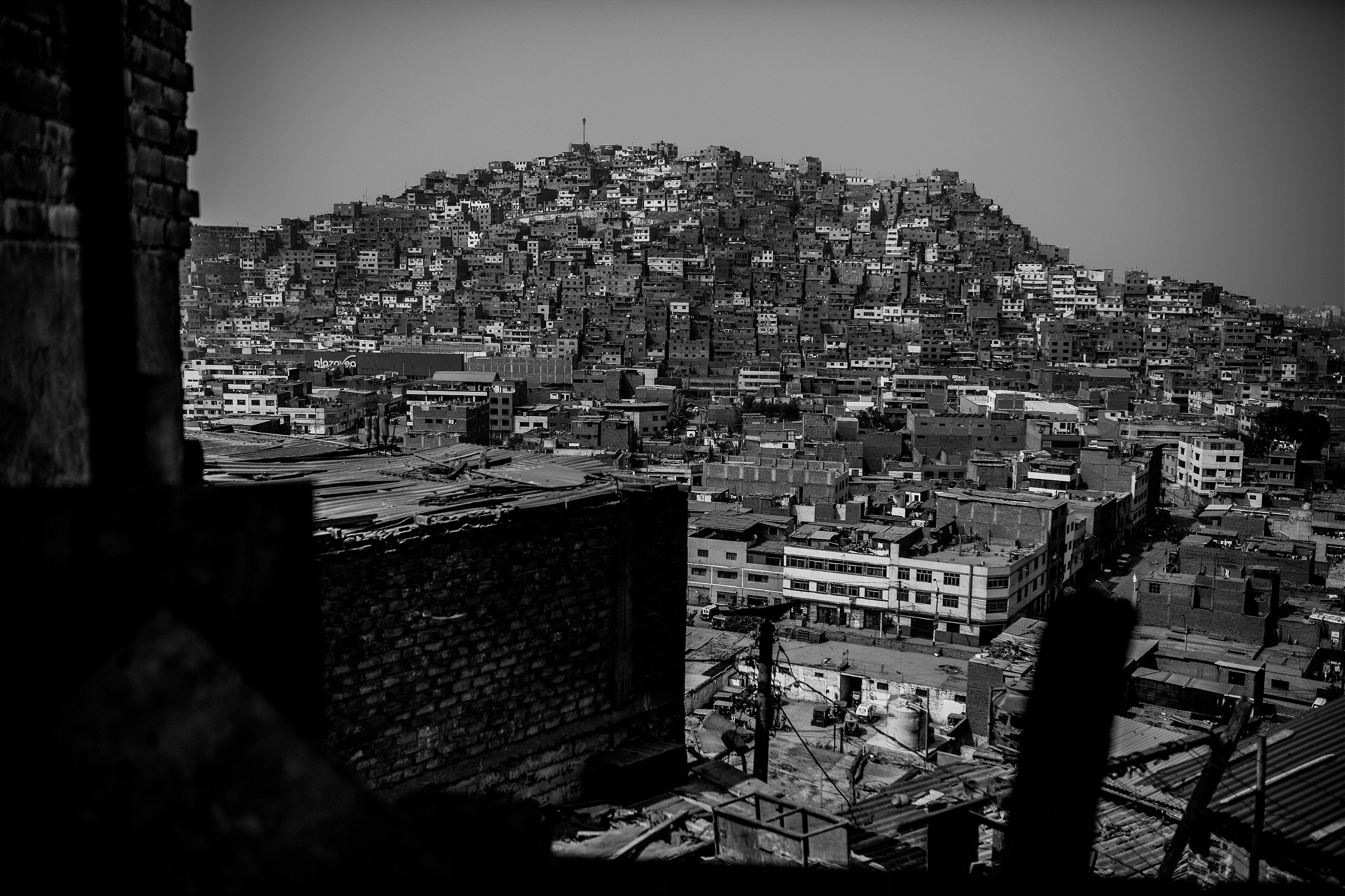
In the aftermath of the event, Acosta played the uncomprehending victim. He told the local media that he had received no death threats and that he didn’t know of anyone capable of planning the attempt.
The press and the authorities, however, knew more. They suspected that Ángel Román León Arévalo, otherwise known as Viejo Paco—Old Paco—was behind the attempted killing. Arévalo was the head of a criminal organization called La Gran Familia, from northern Peru. This gang was in charge of Los Piuranos— from the city of Piura—to which Farfán had been linked. According to the police, the organization had designs on moving to Lima, and their first target was the centrally located district of La Victoria. As one of El Cerro de San Cosme’s most powerful leaders, Acosta was an obvious mark.
News of the assassination attempt provoked many questions on the streets. And one question came up over and over again: were Acosta and his organization that different from the criminals who had targeted him? The answer to this question, however, lay in a wider national narrative. It is a story that tells of vigilantism among Peru’s poorest citizens, and how their struggle, mobilized by social media, came to mirror the crimes they sought to bring to light.
I first meet Acosta at GREVA’s base, which lies at the foot of El Cerro de San Cosme. The group’s headquarters is a rickety construction of concrete and corrugated iron, built over a large courtyard filled with empty tuk-tuks and men engaged in clandestine conversations. Inside, Acosta sits at a desk surrounded by his men. He is 43 years old and wears an inscrutable, dour expression. He has jet-black hair, a great rudder of a nose, and a chest like an oak barrel.
I found out about Acosta and his men while researching a social media-driven vigilante uprising that was then sweeping Peru. A local journalist had put me in contact with them, and told me that, although GREVA was older and less violent than most of those vigilantes making the headlines, its story was just as representative of Peru’s long history of community-led justice.
Acosta greets me formally. I explain that I’m here to find out about Peru’s vigilante culture, and what role GREVA plays in its community. Acosta doesn’t respond. He just gazes at me with an expression as blank as a whiteboard. I explain myself again, but his features are set hard. Acosta’s men, who encircle him as if he were a ceremonial stone, offer no help either. Outside, the crack of a tuk-tuk backfiring echoes through the office.
“You have to talk to him loudly; he’s deaf,” says Jorge Vidaurre, GREVA’s other director, as he enters the room. In contrast to Acosta, Vidaurre has the appearance of a schoolteacher with his neatly pressed chinos, light yellow polo shirt, and crisp blue anorak. “Elmo, he’s asking you what GREVA does in the community.” Acosta nods, and as if wound up by Vidaurre’s words, jolts into an explanation.
He tells me that aside from being a ronda urbana—which loosely means city-watch and is the name Peruvians give to these urban vigilante groups—GREVA also provides job advice and workshops for its close-knit community of reformed ex-cons. Like a trade union, it helps its members fight for better rights in the workplace.
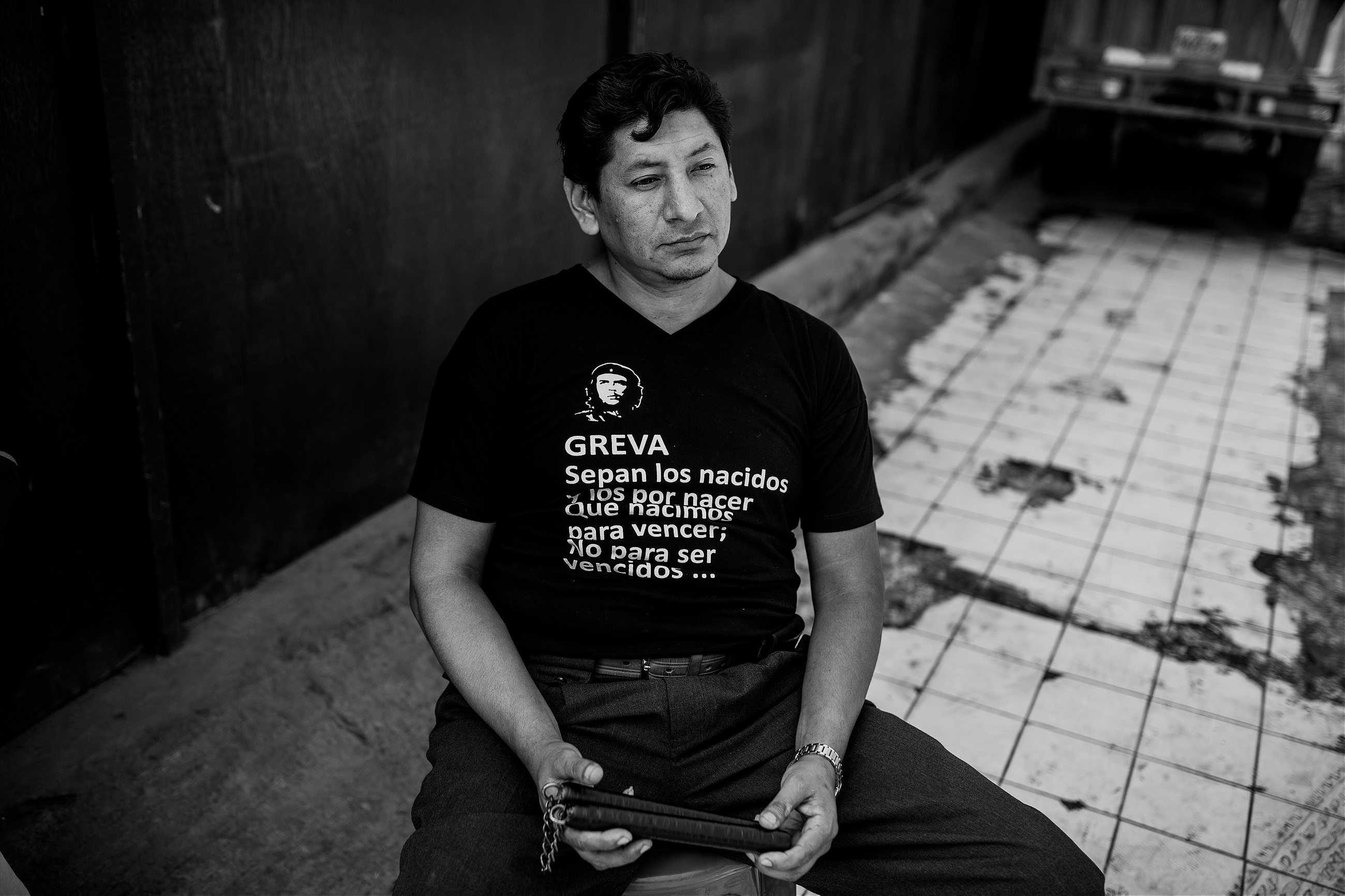
We exit the office and move out into the pale sunlight. The air is humid and ridden with flies; the streets smell of rotting garbage. Acosta wants to do a round of the neighborhood. He says he likes to get out and greet his neighbors and believes it’s important to maintain a presence in the community.
Vidaurre leads us down the office building’s shaky steps, and we leave the courtyard through a large wrought-iron gate. Almost as soon as we step foot out of the base, GREVA members come out of nowhere to greet Acosta. An old man shakes his hand and wishes him good health. A group of youths receive him with an awkward reverence, and a gaggle of agitated women asks him for help. Acosta responds in turn with the authoritative gregariousness and easy confidence of an important man. The type of confidence that, as Acosta himself admits, is born from a difficult past.
Born in La Victoria in 1973 to a poor family, Acosta’s early life was defined by crime and opportunities to stray. During his youth, Peru was consumed by an internal conflict between the government, led most famously by the now imprisoned former president Alberto Fujimori, and various communist armed factions. A disaffected adolescent, disillusioned by the state of society and the poverty around him, Acosta is suspected, both by the press and the local police, to have joined one of those factions, the MRTA (Túpac Amaru Revolutionary Movement) in the early 90s.
The group was a Marxist-Leninist terrorist army that fought to turn Peru into a socialist state. It was a rival of the country’s more famous revolutionary army, The Shining Path, and was responsible for car bombings, assassinations, and the capture of the Japanese embassy. Acosta won’t say what, if any, crimes he committed during his widely-reported time with the MRTA, and he is generally vague when I ask him about his involvement with the group. He does say, however, that the state was so desperate to convict him of terrorism (something they could never prove) that, when he was charged with aggravated robbery in the early 90s, prosecutors used the charge to imprison him as a terrorist. He was sentenced to a decade in prison—from 1993 to 2003—and has been branded an MRTA insurgent ever since.
In spite of the ambiguity surrounding his connection to the MRTA, Acosta hasn’t abandoned socialist politics or softened his revolutionary stance. He continues to idolize Che Guevara and has a tattoo of the Argentine on his right pectoral. His rhetoric remains Marxist, his dislike and distrust of the system holds firm, and his penchant for verbose, didactic soliloquies has never wavered. He still sees in his country an excess of political hypocrisy, social injustice, and economic inequality—and he wants to change it. He is looking for a new social revolution, but one, he says, without violence.
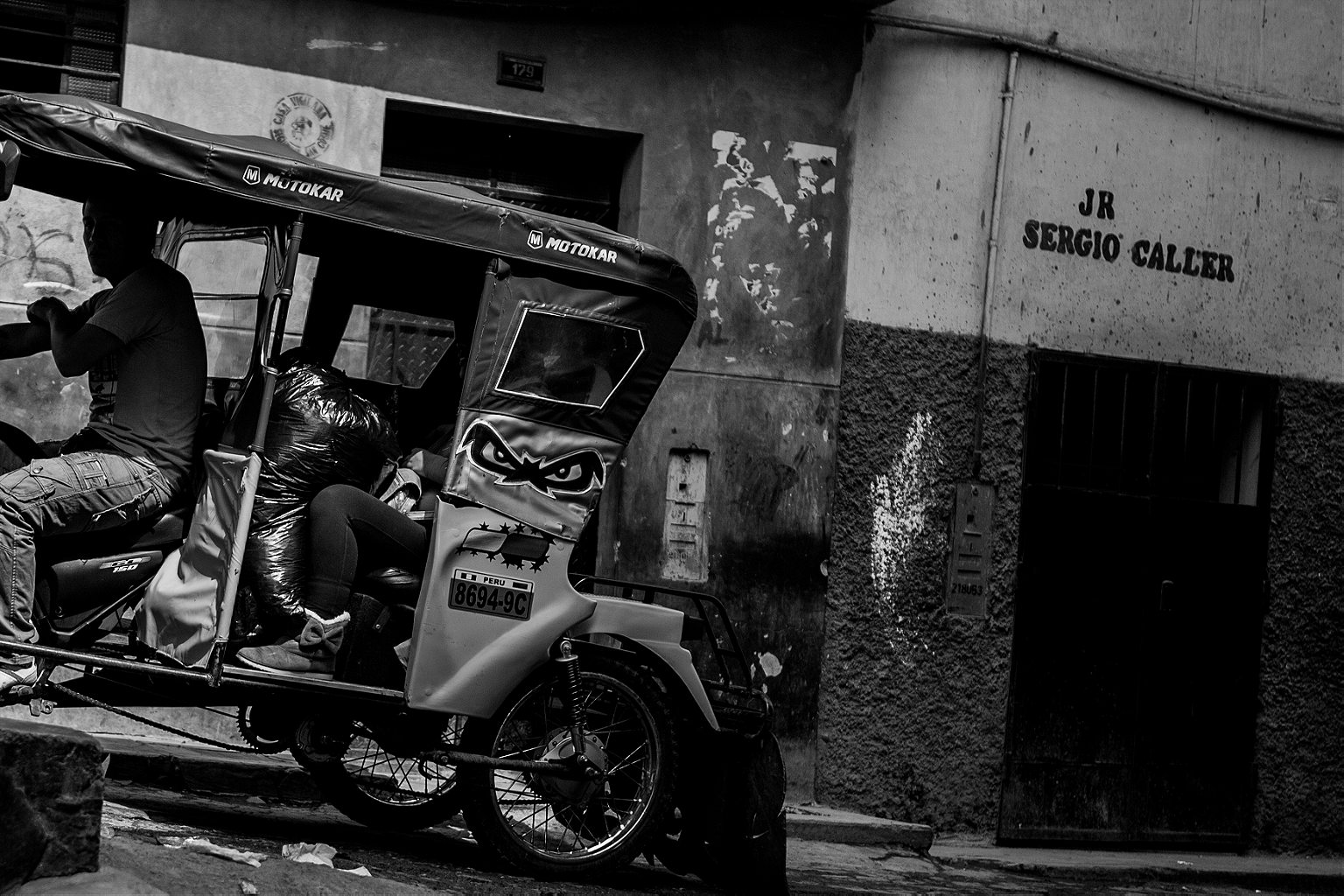
Ahead of us, at the foot of the hill, tuk-tuks buzz and spit and the vendors from the market mumble their prices like auctioneers. We duck through the tight passages and stumble up the narrow, winding stairways. The buildings lean and lurch like Jenga towers. Telephone wires twist and knot like shoelaces and the charred smell of barbecued meat from a local restaurant mixes with the humidity.
Acosta tells me that San Cosme is one of the poorest and most crime-affected areas of Lima; according to police estimates, 2,200 crimes are reported every year. In one of the neighborhood’s narrower streets, he shows me the fumaderos—crack dens—where young and old gather in decrepit shelters to smoke PBC (coca paste) and mixto, a mixture of PBC and marijuana.
Smashed lighters and ripped cigarette papers from the night before litter the ground. Acosta bends down to pick them up and shows them to me with the consternation of a worried mother. “We’ll never get rid of the drugs here,” he laments. “That is an unwinnable war.”
Peru is one of the fastest growing economies in Latin America, with a predicted growth rate of 4.1 percent annually until 2030. But it’s also ridden with crime, the result of state corruption and the drug trade. According to a survey conducted by the Barómetro de las Americas in 2014, 31 percent of Peruvians reported being victims of crime. While the majority of these offenses were robberies, not murders, it was nevertheless the highest rate experienced by any Latin American country that year.
Crime is so prevalent, in fact, that it is rife even among the authorities. From 2011 to 2015, some 1,688 police officers were fired for their involvement in corrupt practices. And in 2014, 92 percent of Peru’s mayors were investigated for presumed acts of corruption. To make things worse, the police force suffers from a huge lack of resources. Eugenio Vallejo Salazar, a Policía Nacional del Perú (PNP) commander in the district of San Martin de Porres, Lima, tells me that in his area there is one police officer for every 500 residents. But what is even more worrying, he says, is that the department, which oversees a region home to almost half a million people, doesn’t even have enough money to supply computers. Sometimes, the staff even has to buy its own paper.

This has created a deep mistrust of the Peruvian authorities. In an IPSOS poll, 55 percent of Peruvians said they did not have any confidence in the police, while 79 percent reported no faith in the judiciary. This lack of trust in the government agencies, and the high crime rate, means that many people in Peruvian cities look to groups such as GREVA to carry out justice and take care of their needs.
Acosta leads us up a steep stairway and onto the quieter streets above the barrio’s main roads; above us the hill rises up sharply into the winter smog. Another reason for this tour, he says, is that he wants me to see the types of people that live here—the people GREVA is trying to help.
Acosta points out groups of adolescent boys guarding street corners. He motions solemnly to a man lying face down drunk in the gutter, moaning, but receiving no help. Finally, he looks on sympathetically as men with deep coughs and blood-shot eyes struggle to climb the barrio’s steep slopes. “TB has been devastating here,” he says somberly. “El Cerro de San Cosme is one of the most affected areas in the whole of Peru.”
When Acosta left prison in 2003 he wanted to prove that he was a reformed member of society. After trying and failing to set up similar initiatives, in 2007 he gathered a group of close friends, some from his childhood, others reformed ex-cons he had met in prison, and set up GREVA. In the beginning, its reputation spread via word of mouth—mostly chats among mutual friends or at community events.
But Acosta saw this wasn’t working efficiently; his revolution was taking too long. So he founded a group magazine, called the GREVISTA. The magazine, which he circulated through the wider district of La Victoria, published articles on the association’s activities, profiles of its members, and scathing op-eds. Despite being very cheaply produced, it proved useful, and the group saw a small increase in its numbers. But Acosta still wasn’t satisfied and wanted to find another method to spread GREVA’s message more quickly.
Around this time social media was becoming popular in Peru, and GREVA’s members saw it as an opportunity to attract the attention of the community’s younger generation. Three years after he founded the organization, Acosta logged on. Using YouTube and Facebook, he began chronicling the group’s activity. He posted events, uploaded videos of marches, interacted with the local community, and made connections with similarly focused organizations from further afield. GREVA immediately saw results, and over the course of several months, its membership grew to over a thousand.
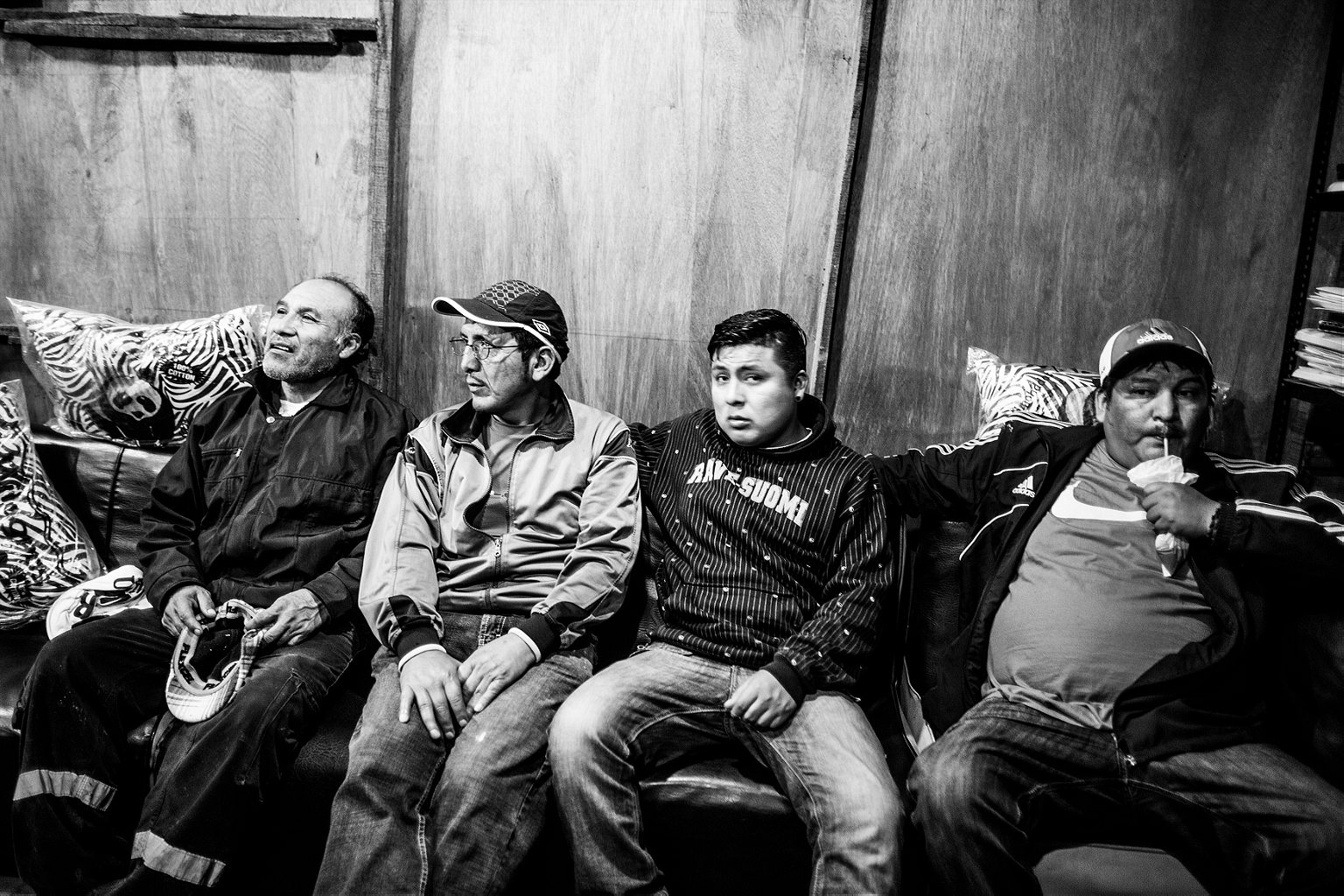
In spite of its success, Acosta says he was aware of the internet’s potential effect on poor, previously disconnected, people. If not used correctly, or used by the wrong group, he believed that the same discontent that he had with Peruvian society could get out of hand, or might spread too quickly to control.
In late August of 2015, it did.
It began with a Facebook page uploaded in Huancayo, located in Peru’s central highlands, by journalist Cecilia Garcia. The post—titled “Chapa tu choro,” or “catch your thief”—rallied citizens to apprehend and punish petty criminals, without the assistance of the law. The message had an immediate impact—the page gained more than 12,000 followers in a week—and small vigilante groups began to form in the poorer areas of the city. These groups began patrolling their neighborhoods, capturing those who had previously tormented them. To prove their effectiveness, and to entice other cities to join their movement, they started to post videos of their vigilantism online—most of which contained scenes of torture. In a matter of months the movement had reach all of Peru’s major cities.
The ‘Chapa tu Choro’ uprising has since dissipated. There were public cries of corruption, in which the group’s founders were denounced for using the uprising to forward their political interests. Cecilia Garcia, particularly, was accused of using the movement’s popular appeal to launch her bid to become a member of Peru’s Congress.
More detrimental, however, was the group’s excessive and unjustified violence. In some areas, participants became so trigger-happy they started punishing the wrong people; assaulting and killing innocent locals who merely bore a resemblance to the wanted criminal.
In October 2015, Carlos Torres Velasquez and his friend were attacked in the south of Lima by an angry mob of vigilantes who had mistaken the young men for local thieves. They stripped them, pelted them with stones, and beat them with baseball bats. The police intervened at the last moment to save the victims’ lives. A month earlier, in Andas, in the region of Huanuco, Emerson Roque and Miguel Mauricio were not so lucky. The youths were tortured and burned alive by a group of 20 vigilantes. Local newspapers reported that the boys had gone to collect wages for work they had done in an illegal mining camp. Their boss, however, didn’t want to pay them and spread word that they were criminals.
These types of vigilante movements have been around for a long time, says Jorge Yamamoto, a sociologist from the Pontificia Universidad Católica del Perú. “They started off as rondas campesinas in rural areas in the 1970s and entered the cities with the urban migration in the 1990s and early 2000s.” The difference with “Chapa tu Choro,” says Noam Lopez, an anthropologist from the same university, is that through social media it “mobilized itself more quickly and powerfully than any other vigilante movement previous.” Facebook’s connectivity meant that poverty no longer precluded the exchange of ideas. It also made public what was once private, putting the vigilantes’ violence up for national scrutiny.
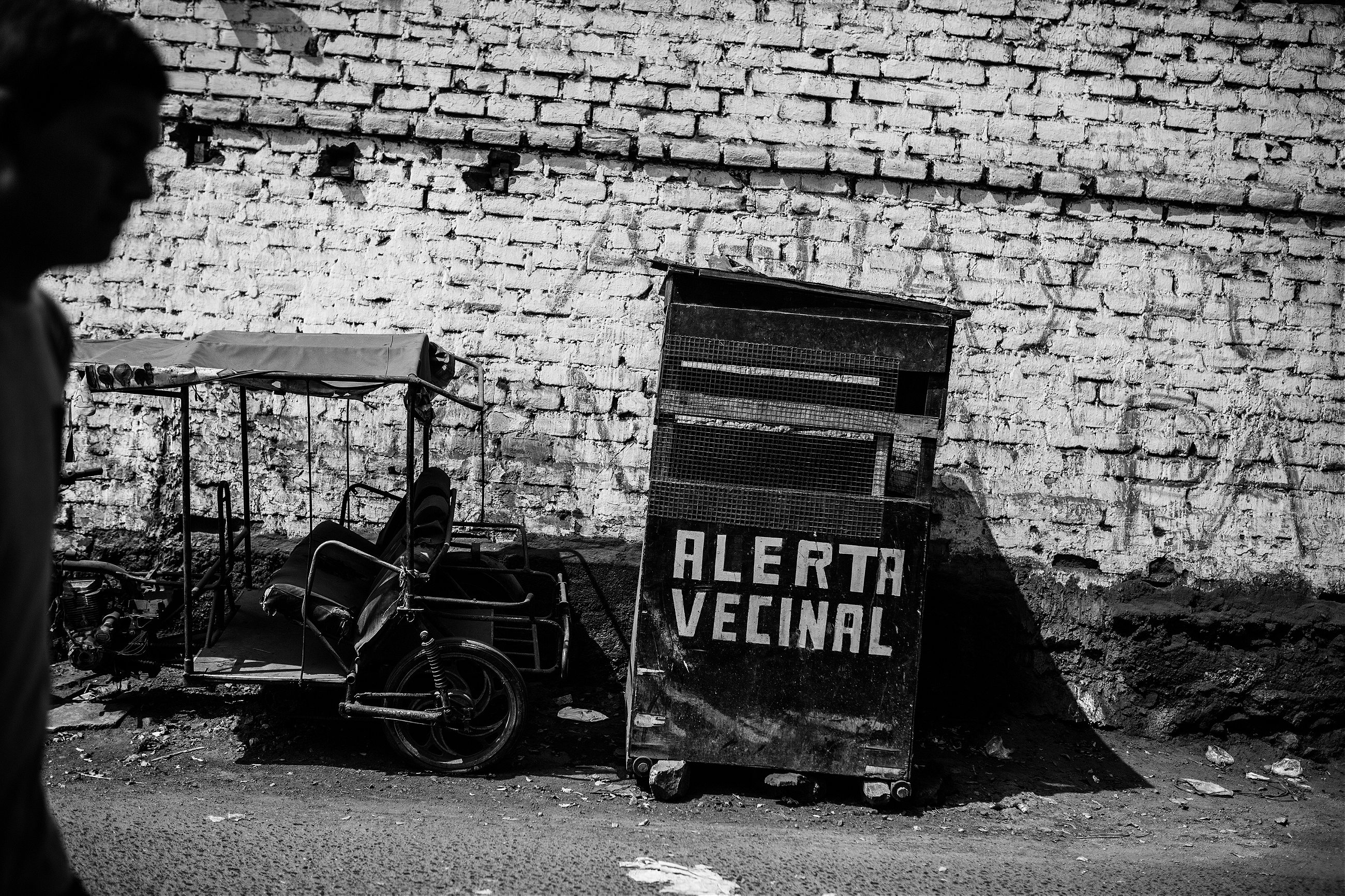
We reach the highest point of San Cosme. In front of us, Lima sprawls out to the horizon, an urban carpet covering every inch of visible land. “The violence of ‘Chapa tu Choro’ is against our beliefs,” Acosta says, picking up more PBC leftovers from the ground. “If we catch a criminal, we hand him to the police. We’re not an authority or a judicial system, so we have no right to administer punishment.”
Vidaurre tells me the group watched the uprising with a mix of excitement and disappointment. It was partly the rebellion they sought, only it used methods they didn’t condone. They wanted to work with the authorities, the men say; it was just that the authorities didn’t always want to work with them.
Acosta stops to rest. Years of climbing the neighborhood’s treacherous inclines have damaged his ligaments, and when the temperature drops during these winter months, he struggles to walk. While he recovers, I take the opportunity to ask him why he thinks GREVA is doing the police’s job. Acosta points to a small commissary below us. “Empty,” he murmurs. “We are here for the community; we know the community. The police are not here, and they do not know us.”
Acosta’s rhetoric is compelling, but to many in San Cosme, that is all it is. They say that GREVA, wrapped in alluring ideals, does not turn its impassioned soliloquies into deeds.
Some locals are willing to go further, stating that the lack of government presence is not enough to justify GREVA’s intervention if intervention means employing the same tactics used by the criminals it tries to eradicate. ‘Chapa tu Choro’ did this and, according to these locals, Acosta does it, too.
“Many here are scared of GREVA,” says a San Cosme local who didn’t want to be named. “They pretend to be a benevolent organization, but they have no mandate to police the area, and sometimes interfere with the community rather than helping it.”
Guillermo Álvarez, the priest of the barrio, says that the group “goes about threatening everyone.” Álvarez told local news outlets that he was confident that GREVA’s daily bread is not rehabilitation and community support, as they repeatedly profess, but drugs, money, and social revolution. “The acronym GREVA supposedly stands for ‘Gremio Resocializador de La Victoria y Alrededores’,” he says, “but we know that in their meetings when their masks are removed, they call themselves ‘Grupo Revolucionario Emerretista Violencia Armada’”—the MRTA Group of Armed Violence.
Acosta says that these are all lies. “The authorities and the press focus on our pasts. They say people like us can never change, and for that, we are portrayed as a gang of ex-convicts running wild in the neighborhood. But why should we be embarrassed for having a history, when they are as corrupted as they are?”
Acosta believes that GREVA’s exploits have created jealousy and suspicion among some members of the local government because it is through the group’s work that the authorities’ malfeasance is uncovered.
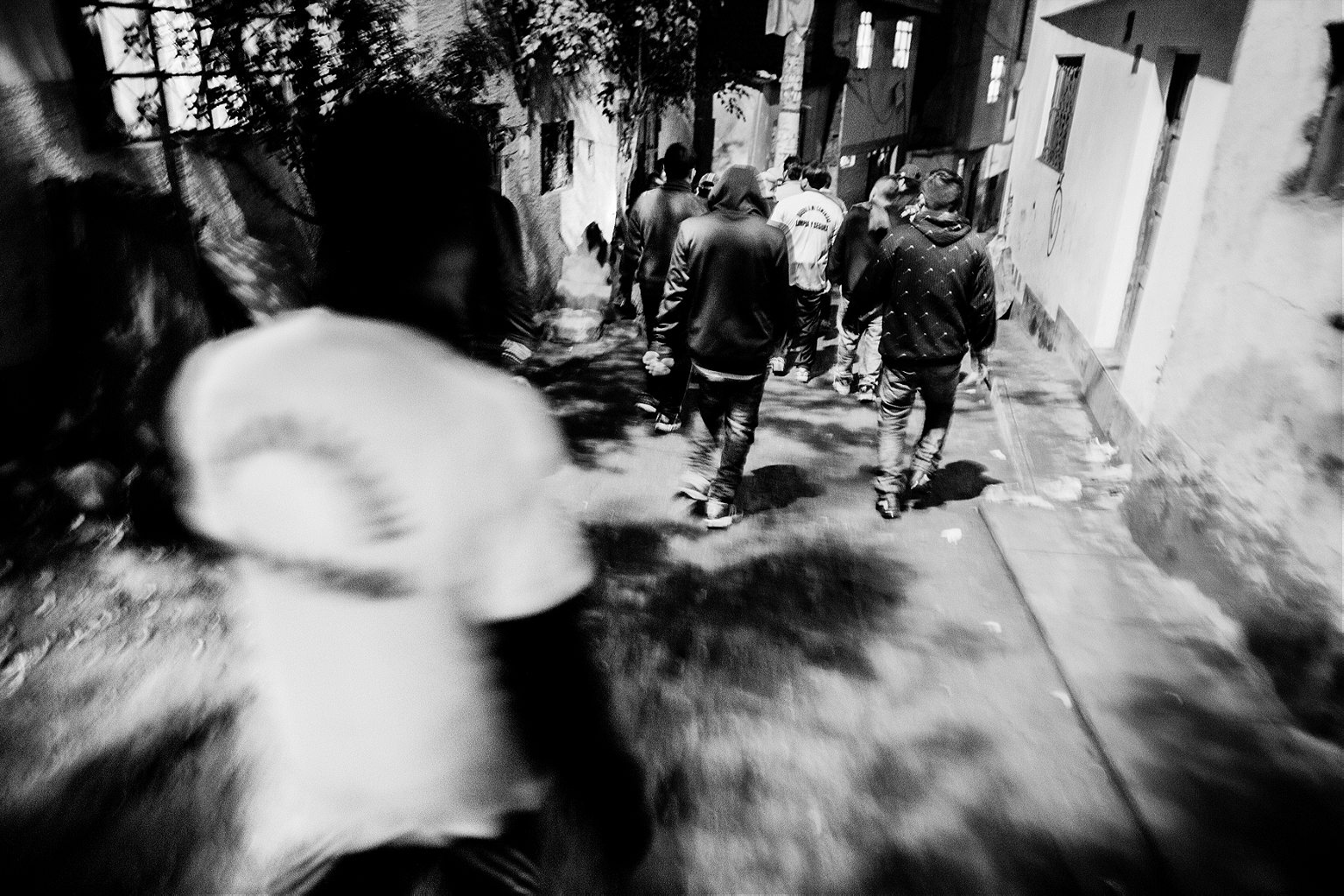
It seems that word of my visit has spread. Around us, young men in baggy pants run up and down the slopes, irritating the older GREVA members and shouting at me in broken English. Acosta ignores the commotion. Before we end the walk, and the day’s meeting, he wants to take me to a local restaurant that the organization helps run. At the bottom of a long pedestrian street near GREVA’s base, we enter El Comedor Popular 13 de Mayo through a low doorway. Inside the small dining room, where GREVA holds meetings and community events, Acosta points to the photographs of the group that hang on the walls. He chuckles to himself and pauses.
Among the photos are many shots of the leader, the same stern expression etched on his face, and the peace sign made with his right hand. These are the photos that litter his numerous Facebook pages, the photos that, like his socialist heroes before him, Acosta has used to create his own aesthetic.
His mood soon turns. “Those days are gone,” he huffs. He tells me that GREVA’s numbers have dropped to only 200 members and that it’s losing its influence in the community. “A lot of the young guys who would have joined now don’t because they think GREVA is illegal or a terrorist organization.” But Acosta is adamant that they are not the real criminals. The real problem, he says, are the local politicians.
Two days later, I return to GREVA’s base late at night. It’s pitch black except for the lights from Acosta’s office. Outside the door, men linger on the balcony, sharing beers and nodding their heads to cumbia music. Elsewhere, people in white t-shirts that read ‘Ronda Vecinal’ (‘neighborhood watch’) prowl the perimeter of the courtyard, shouting into their phones. The men have invited me to take part in one of their twice-weekly night patrols. They want to show me how they have been lowering crime in the neighborhood.
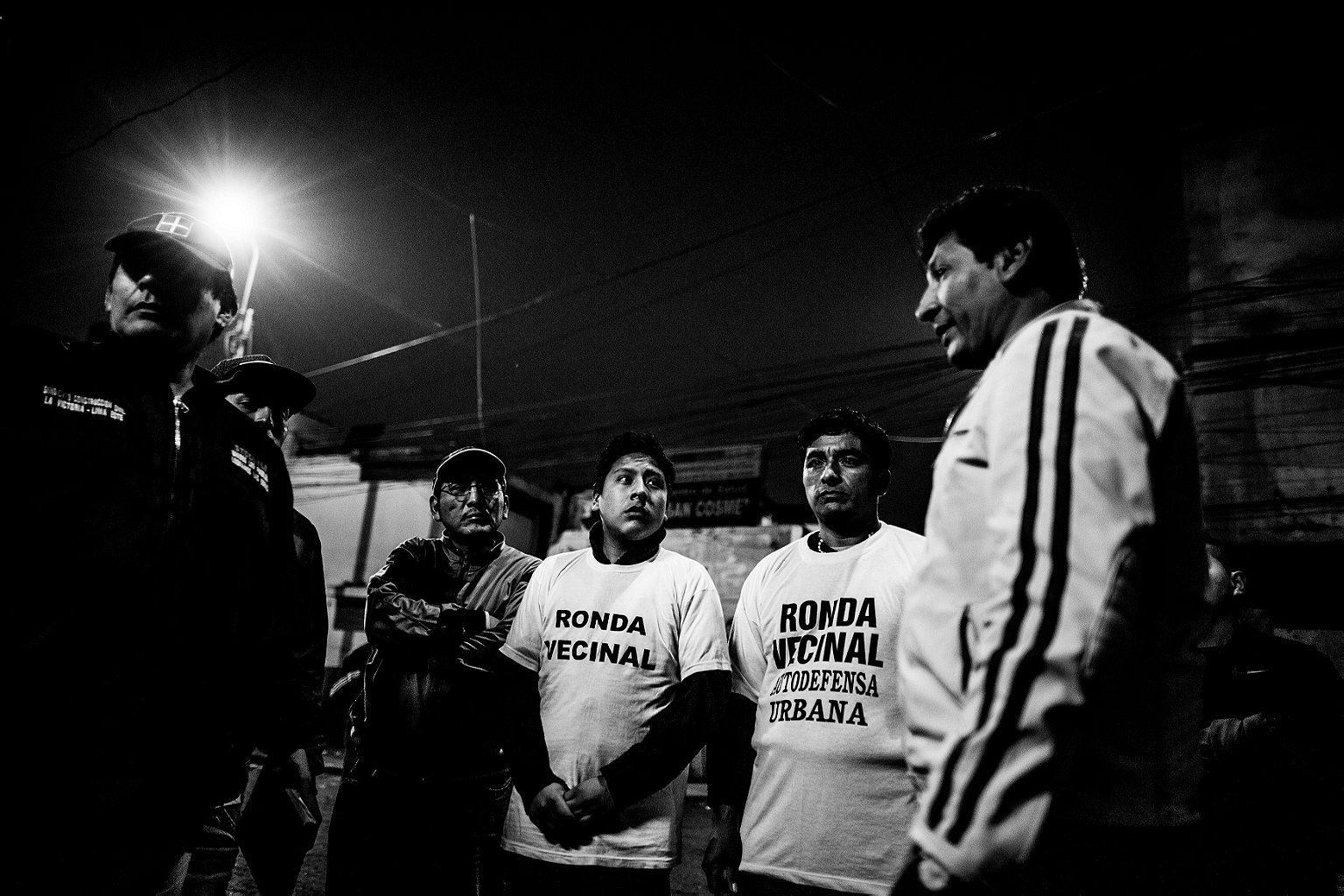
San Cosme is almost unrecognizable at night, and, at first, we see very little. The alleyways are deserted, and there is no noise but for the group’s chatter and the distant hum of the traffic below. Then Acosta spots something—a flicker of movement, the glow of a cigarette. Three figures appear from the darkness. Startled by the group’s shouting, two of them scamper up a nearby passage, while the other stands motionless, seemingly unable to move.
The men at the head of the patrol lurch forward into a sprint, shining their flashlights in unison. The jaundiced light flashes on the remaining boy’s face and reflects off the luminous strips on his tracksuit. The men scream at him and throw him around. But the boy, completely stoned, doesn’t respond.
They stuff their hands into his pockets, lift his shirt and pull down his pants. The boy’s head falls to his shoulder; his eyes roll back into his skull, and he slumps to the floor. The remainder of the group watches or takes pictures. One member uploads his photos to WhatsApp and others post selfies of the patrol to Facebook, their pride in the group’s actions blinding them to any moral concerns others might perceive.
The members find nothing of consequence: a lighter, cigarette papers, tobacco. I must have looked skeptical because Vidaurre quickly justifies the vigilantes’ actions: “We have to be rough,” he says, as the patrollers order the boy to return to his home. “If the criminals sense any weakness or indecision in our boys’ approach, he will take control of the situation, and that could mean problems for us.”
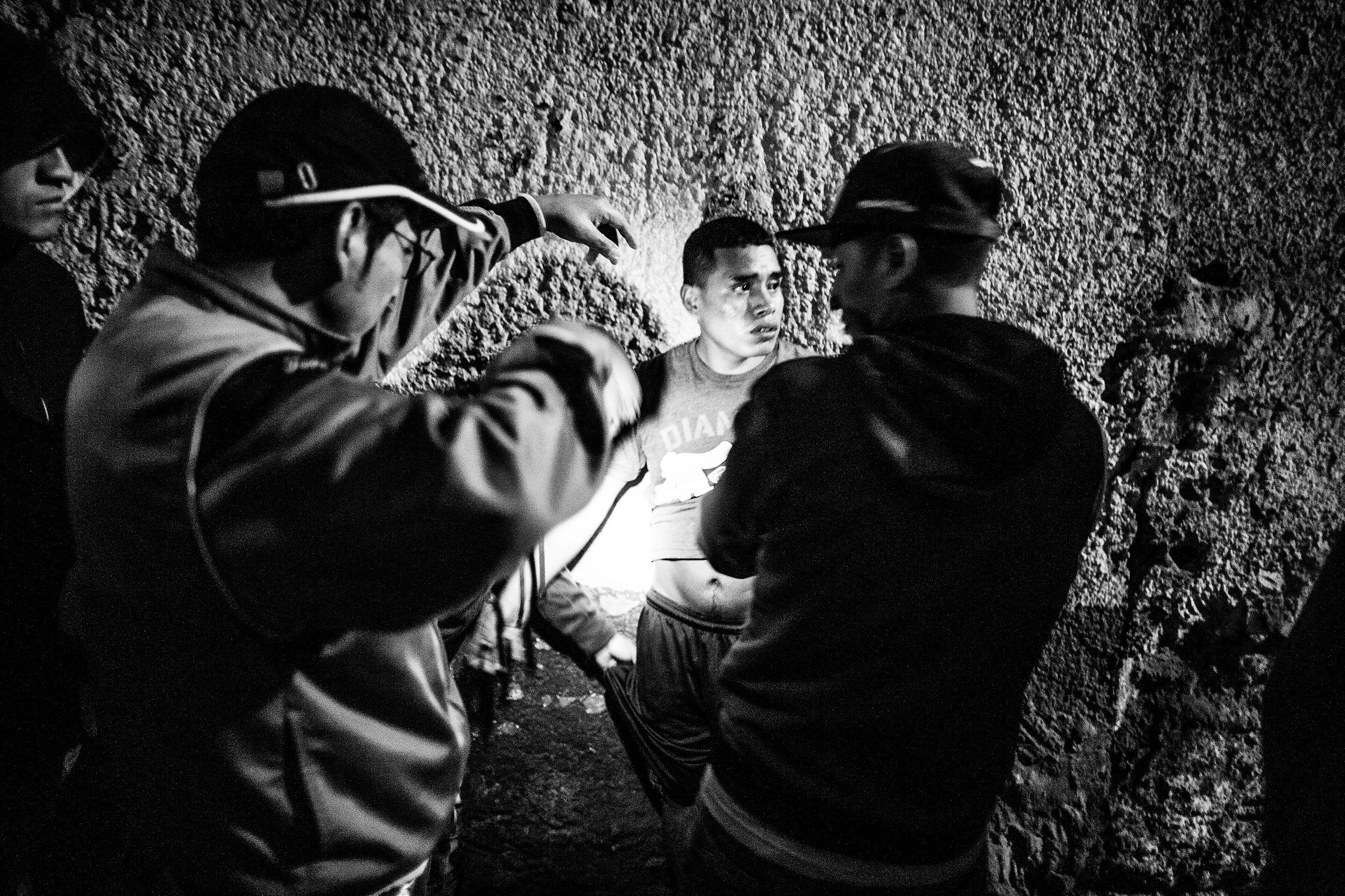
As we continue through the streets, I notice that many locals, those who are not engaged in criminal activity but merely walking home, shy away from the group. They seem afraid. Neighbors shut their doors as we approach, and some people lower their gazes as we pass. I ask Vidaurre about their reactions, and he replies impassively: “There are some people here that don’t like what we do, but then that’s the case with everything.”
At that moment, as the patrol regroups by the main road to decide on their route, a police car passes. The officers inside peer suspiciously out of their windows and the GREVA members stare back blankly. There is no exchange of information, no collaboration, just indifference. The flashing patrol lights disappear into the night.
When GREVA was at the peak of its power, Acosta’s rap sheet only grew. In August 2012, he was convicted of extortion. It turned out that GREVA was extracting protection payments from local construction companies and forcing job vacancies for its members in those same enterprises. Some months later, he was charged with paying members of GREVA, among them ex-hitmen, to start a riot against the police in San Cosme. In late 2012 and early 2013, Acosta was investigated for plotting two failed assassination attempts on local politicians who were impeding the organization’s activity in the community.
In each instance, Acosta was detained and interrogated by police, but soon freed.
His story is typical of what happens to the ronda urbana, says Jorge Yamamoto. “The state’s absence leaves a large power vacuum that the rondas fill. But because these groups are not experienced or educated enough to avoid the type of corruption they see in society, they, too, become corrupted by power.”

Of course, the intentions of these vigilante groups vary from case to case, but generally, they aren’t fundamentally bad. The Peruvian National Police is woefully understaffed, and although local municipalities have endeavored to provide auxiliary safety services, called the Serenazgo, there are still not enough people surveilling Peru’s most deprived areas.
Unable to eradicate these vigilante groups, the police may, in fact, benefit from the help and in-depth information that experienced local rondas can provide. But this will only come with structured collaboration; left to roam the streets independently and working within a corrupted bureaucracy, groups like GREVA can go astray.
Alberto Jordan, a former general in the PNP, believes that there needs to be a rapprochement between the authorities and these groups. “Right from the beginning, rondas should come into the police academies and inform the police what they are trying to do in their neighborhoods.” If this doesn’t happen, says Jose Luis Lavalle, Director of Criminal Investigation in the PNP, these vigilantes will continue to undermine the rule of law while proclaiming that they uphold it.
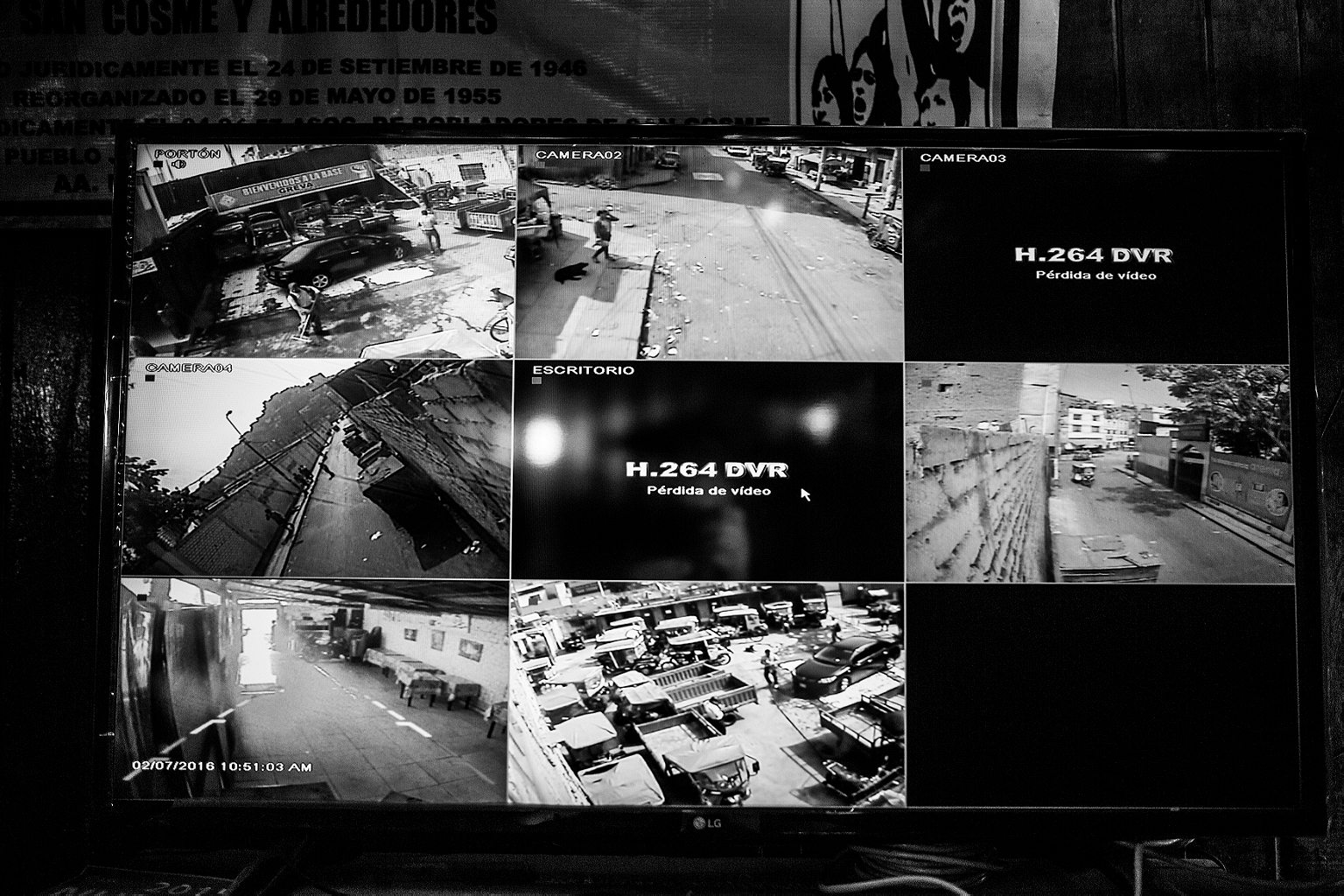
This is where technology is helping.
Social media mobilized public discontent in the ‘Chapa tu Choro’ movement in a bigger and more violent way than had ever been seen. But its accessibility, the fact that these violent videos could be so easily viewed online, made a type of vigilante justice that was once clandestine more visible. It allowed Peruvian and international observers to witness something that had undoubtedly gone on in secret for many years. And it forced this audience to see the flaws not only in the police and judicial systems but in the people’s own methods of justice-seeking.
In this way, social media both expedited and uncovered a phenomenon that may have gone unnoticed, or ignored, for many years. It forced a dialogue between the state and its people about security, police corruption, and vigilante violence. And it forced the country to see how men like Acosta were merely aping the corrupt system they so vehemently criticized.
Reports from scouts further up the hill say that the two escaped drug dealers have been spotted near the barrio’s summit. Acosta senses an opportunity. He splits the party in two, and sends us off with a nod.
There are fewer streetlights in higher part of San Cosme, and as we climb the stairways, I watch the men disappear into the pockets of darkness as if under a strobe light. They breathe laboriously, stumbling on the broken asphalt as they heave themselves up the stairways. Their heavy footsteps and frantic conversation cause dogs to bark and growl from the shadows.
When the two groups meet at the summit, they see only themselves and hear little more than their panting. This often happens, and the men are used to it. Darkness is a reliable refuge. Before he leads the way into the gloom, Acosta turns to us with a grim look and tells us not to become complacent.
“The night here is full of surprises,” he murmurs.
